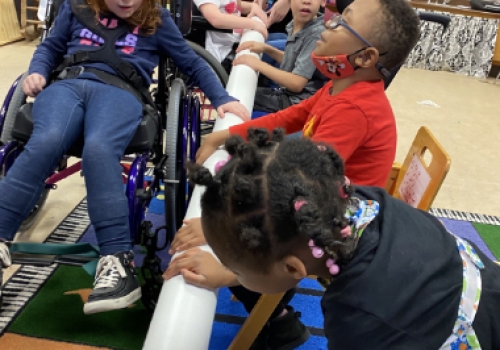News

Day 49
Music classes are offered at each of our three schools at the South Carolina School for the Deaf and the Blind (SCSDB). Lauren Stanaland graduated from the University of Georgia with a dual bachelor’s degree in music education and music
therapy with a dream of working with the Deaf and blind population. She is a board certified music therapist and certified
music educator, currently pursuing a master’s degree in music education at Converse University. She is a percussionist and also plays guitar, ukulele, and piano. Lauren worked as a music therapist at a private practice in South Florida for two and a half years with populations such as adults/teens with substance abuse, geriatrics with Alzheimer’s/Dementia, hospice, children in mainstream schools, children with disabilities, etc. She then taught music at a school for students K-12 with emotional behavioral disorders in Georgia for four years. Finally, Lauren is currently working with her dream population at the South Carolina School for the Deaf and Blind. This year she is starting her fourth year teaching at the school. Often, Lauren implements music therapy with the students at Cedar Springs Academy in which she accomplishes non-musical goals. She often writes her own songs and uses manipulatives to individualize the specific needs of her students. She implements her music education background by pursuing musical goals as well. She looks forward to continuing to work on new and exciting ways to teach the students at SCSDB.
Lauren Stanaland, Carrie Paige, and Josh Padgett from SCSDB presented about Arts accessibility and Arts integration at the PSAE conference last year. Lauren Stanaland also presented a two and a half hour long presentation at a Music Therapy conference at Converse University about music technology with the Deaf (left image). In these presentations, Lauren detailed all of the different apps and devices used in her classroom. Most of these examples included arts integration by simultaneously teaching science and music. Some examples included the Makey Makey, Soundmoovz bracelets (mostly for Visually Impaired students but it also provides a visual on the screen for Deaf), and different objects she uses for students to visualize and feel sound waves. The Makey Makey is a circuit board connected to a computer. The computer recognizes it as a keyboard and different websites are used to make different instrument sounds. The alligator clips can be connected to anything that conducts electricity such as fruit, vegetables, people, plants, etc. Lauren taught a science lesson about circuits using the Makey Makey as a guest at the blind school science classroom as well as in her music classes throughout campus. (https://makeymakey.com) Laser sound wave experiments were also used to visualize sound.
Music therapy goals are individualized and differ student to student. Some common examples I use at SCSDB include:
- Gross and fine motor skills (palmer and pincer grasp, etc.) accomplished by dancing/movements
- Speech therapy goals accomplished with singing/signing
- Cognitive/academic goals accomplished with arts in basic curriculum (literacy, science, math, etc.)
- ASL goals accomplished by signing songs
- Social/emotional goals accomplished by social interaction songs, emotion identification songs/activities, songwriting, etc.
- Arts goals accomplished by integrating art activities as part of music
Music Education goals are based on the South Carolina national standards. I follow a curriculum map based on the
standards I have adapted for our students. They include specific music goals I will summarize here:
- Arranging and composing music
- Improvising music
- Singing/signing
- Playing instruments with proper technique
- Reading and notating music
- Analyzing music
- Evaluating music
- Examining music from a variety of stylistic and historical periods and cultures
- Relating music to other arts disciplines, other subjects, and career paths
In addition to instruments, Lauren uses plywood ramps on which drums and the students feet are placed, and a large PVC pipe connected to an amp for students to feel sound vibrations with their feet. This allows their hands to be free to make music. Lauren also teaches math and literacy in lessons by adding up rhythms and forming sentences with rhythms. The drum booth located in Lauren’s classroom was built using funds from the SCSDB Foundation. It is used to help dampen the loud sounds of the drum set in order for nearby classes to not be disturbed or upset by the loud sounds while they do their school work. They are very grateful for the time, effort, and funds from the Foundation to provide this for our students.
The image on the previous page depicts a classroom with the drum booth on the far right. The image at the top of this page displays children with their hands on a PVC pipe to feel vibrations of an instrument.
#scsdb #engageempowerequip #daysofgiving #demisemideptcentennial #day49
© 2025 SC School for the Deaf and the Blind Foundation. All Rights Reserved|
Privacy Policy | Cookie Policy |
Site by: ALINE, A Marketing Company



